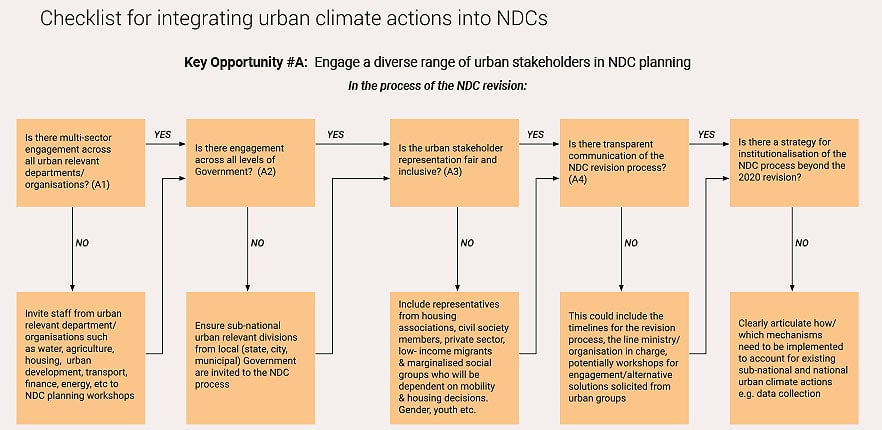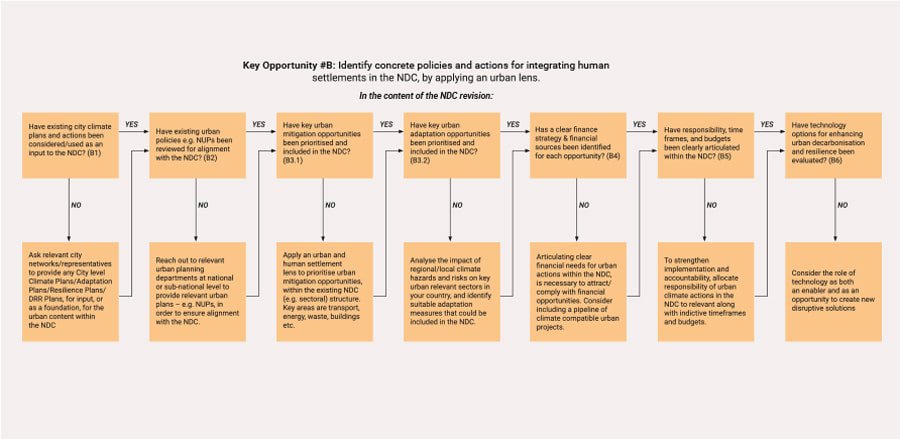National Climate Action: Why Cities Matter
Cities around the world want to ensure the placements of urban content in national climate actions. Responding to this demand, UN-Habitat presents their new guide “Enhancing Nationally Determined Contributions (NDCs) through urban climate action”.
Cities and Climate Change
Cities matter: globally, they house more than 55 per cent of the world population and this number is expected to increase to 68 per cent by 2050. Cities are drivers of economic prosperity and hubs for social and human development. But they also generate a significant share of global greenhouse gas emissions and their concentration of people and infrastructure make them vulnerable to climate impacts, in particular the urban poor. Cities are also laboratories for new climate technology and new disruptive opportunities to respond to climate change.
Five years since COP21 in Paris, 2020 is a significant moment for global Climate Action with the start of the Paris Agreement, the global commitment to limiting warming to well below 2 degrees Celsius or 1.5 degrees Celsius. Countries plan to put forward their ‘enhanced or revised’ climate commitments (their Nationally Determined Contributions – NDCs), which outline their greenhouse gas (GHG) reduction and adaptation efforts, before COP26 in 2021.
What do NDCs have to do with Cities?
Urban areas are the source of a significant share of GHG emissions, up to 70 per cent. Focussing on these sources can contribute greatly to NDC commitments. Also, cities offer effective climate adaptation opportunities targeting large populations and important economic sectors. To mobilise these opportunities, low-carbon and risk-reducing infrastructure, effective institutions, and finance is necessary.
It is in the national interests that local, state, and national actions align for maximum impact, and that local actions are compatible with the Paris Agreement goals, national strategies, and commitments. A vertically integrated collaborative approach allows national governments to realise the mitigation potential through continuous dialogue with sub-national actors and encouraging sub-national action in NDCs.
Opportunities to mobilise climate finance for city projects that are aligned with NDCs is another opportunity. UN-Habitat has recently outlined a comprehensive approach to vertical climate integration.
How can Urban Climate Action Enhance NDCs?
Analysing the existing NDCs, we found that 68 per cent of countries do include references to sustainable urban development. Yet member states were still asking us: if urban areas contribute significantly to global emissions, and if our cities are so vulnerable to climate impacts, what can we do to ensure the urban content of national climate actions (NDCs) is increased?
UN-Habitat convened an expert group of urban practitioners, climate change specialists, and government officials at the margins of COP25 to consider answers to this question. The new guide ‘Enhancing Nationally Determined Contributions (NDCs) through urban climate action’ identifies two areas of focus.
1. Engaging a diverse range of urban stakeholders in NDC planning and implementation. NDCs can be enhanced through transparent communication of the NDC revision process, giving a diverse set of stakeholders the chance to provide quality inputs and engage. Coordinators should engage across sectors of all urban-relevant departments and organisations, and with all levels of government (national, subnational, and local), ensuring a fair and inclusive urban stakeholder representation.
The guide is replete with examples from existing NDCs and national governments. One such country is the Dominican Republic. The national government is looking for detailed information on local climate actions that are currently being implemented by subnational governments and non-state actors. This will allow the country to monitor progress and enable increased ambition in national targets. They are also planning to establish sub-government structures and bodies to set local targets and oversee NDC implementation.
Another example comes from Myanmar, where the inclusion of “sustainable urban development” in their Intended Nationally Determined Contributions (INDC) was supported by wide-ranging consultations with District representatives, as well as a Chief Technical Advisor on climate change who had a background in urban development and planning.
2. Identify concrete policies and actions for integrating human settlements in the NDC, by applying an urban lens. Is the new NDC building on existing city climate and resilience plans and actions that are already contributing to NDC targets, and has the alignment with existing urban policy been assessed? Have urban mitigation and adaptation opportunities been conceptualised? Is there a clear finance strategy for each urban mitigation and adaptation opportunity, with responsibility, time frames, monitoring frameworks, and budgets considered? Have technology options that may enhance decarbonisation and resilience of urban environment been evaluated?
The list for urban climate action opportunities is almost endless. In this guide, opportunities have been presented sectorally across mitigation and adaptation, as this in a natural entry point into the NDC process, and many governments are currently working in this manner.
Countries can reduce city level emissions by 90 per cent with existing available technologies and an urban spatial approach to realise both mitigation and adaptation potential associated with integrated urban systems, a recent flagship report notes. Ideally, considering the inter-relationships between mitigation and adaptation benefits in the planning process can leverage even greater opportunity and long-term resilience.
Many such examples exist of, for example, combining water efficiency measures and innovative urban water management systems or of using Nature Based Solutions such as urban greenery and forests that act as both carbon sinks and as a means of water retention, as flood control as well as response to the urban heat island effect.


Now it is your Turn!
UN-Habitat hopes that this guide helps urban practitioners to better engage with the NDC process and support governments to enhance ambition by integrating urban and human settlement issues into NDCs. We also hope that it will be a useful resource for, and contribution to, government efforts to improve low-carbon and resilient national and urban development, by inspiring NDC teams to strengthen their collaboration with urban stakeholders and activate cities as a source of climate action potential. We stand ready to support member states in this endeavour and continue to work alongside national governments to apply this guide.
- Why the Way We Work Together Will Determine Our Future - 26. June 2018
